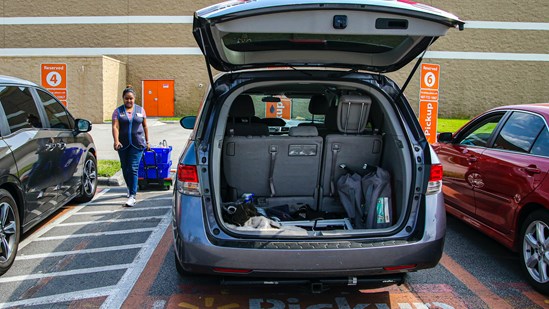

Retail trends: Rise of ‘kerbside e-commerce’ creates in-store warehouses
Whilst e-commerce hybrid models like kerbside click and collect offer potential for retailers to improve their range of services for customers, they mean operating a retail store in a similar way to a mini warehouse. So a WMS comes in handy.
One of the big new shopping trends to emerge as a result of Covid-19 is ‘kerbside e-commerce’. Rather like click and collect, it bridges the gap between online shopping and physical retailing but offering the next level of convenience and safety to consumers. Instead of waiting for a home delivery or entering a store to pick up orders, shoppers can just drive to a central collection point and pick up their goods – for no extra fee.
Perfect for today’s ‘new normal’ pandemic life, ‘kerbside e-commerce’ or BOPIS shopping – “buy online, pick up in store” – has been especially useful during the Covid lockdown. It has introduced millions of shoppers to a convenient channel that they may be unwilling to give up, even as restrictions ease.
According to a survey by Adobe Analytics, rates of both kerbside and in-store pick-up e-commerce surged 208% between 1 April and 20 April in the US. Suggesting this is a permanent trend, 23% of online shoppers in the survey also said they preferred some form of click-and-collect over having orders delivered to their homes. If you have access to a car and time on your hands, why not?
McKinsey has also verified the wider growth of other ‘buy online, pick up in store’ (BOPIS) models of e-commerce, including Ship from Store. And these hybrid e-commerce services are expanding everywhere now, with retailers including Aldi and Coop announcing plans to offer kerbside and ship from store services in the UK. To stay competitive and keep their market share, this trend towards e-commerce hybrid offerings means retailers will need to continue refining and improving their omnichannel services.
Whilst e-commerce hybrid models like kerbside click and collect offer potential for retailers to improve their range of services for customers, they mean operating a retail store in a similar way to a mini warehouse. Goods need to be accurately picked and dispatched within a set timeframe for instance. Kerbside models also provide a way to eliminate last mile delivery, which is one of the hardest and most costly aspects of the e-commerce supply chain for retailers to control.
Ideally a retailer adopting the kerbside model will be using a best-of-breed WMS (warehouse management system) integrated across all its distribution channels. This offers the benefit of reducing costs, because fewer in-store operatives are needed to pick the orders. It also improves stock visibility to avoid disappointing customers and streamlines the returns process, which can become a potential bottleneck and source of missed sales opportunities. Handling returned goods needs to be as automated as possible, with full identification of returned items from a single barcode scan. These features (and many more besides) are available with any best of breed WMS.
Most importantly, using a WMS also allows the retailer to see a single, consistent view of the customer, which is essential for building brand loyalty. Brand loyalty is even more important to develop in today’s retailing environment. The current, Covid conscious consumer is more likely to consider alternative retailers and shop around than ever before. This is reflected in additional brand research by McKinsey, which found that more than 75% of consumers have tried new brands, places to shop or methods of shopping during the Coronavirus pandemic.
How can a WMS improve your click and collect operations?
To be successful at click and collect or kerbside e-commerce, retailers need to be able to transform their existing in-store areas into a mini-warehouse operation where workers act as both customer service representatives and pickers.
Here are some recommendations:
- In-store picks are just like standard warehouse picks and can be optimised by assigning efficient pick routes and using the WMS to implement dynamic slotting. This means storage space (which is probably tight in a store) is used as effectively as possible to hold in-store inventory.
- Calculate the total time needed to complete an order fulfilment cycle for a click and collect order to monitor profitability. Do this by tracking individual picker accuracy and creating a benchmark for continuous performance improvements.
- Consider the impact of click and collect on existing in-store resources. It may be more efficient to recruit additional workers who only focus on handling online orders and click and collect, rather than expect people to cover all operations.
- Use data analytics to track purchases and operative performance, comparing click and collect orders with traditional in-store and ecommerce sales. Analysing this data allows any issues with picking processes to be finetuned and for potential problems that lead to delays in picking online orders in the store to be investigated.
There are many benefits of using a WMS in the retail environment to improve click and collect or for kerbside e-commerce pickup services from the retail outlet. A WMS will help improve stock visibility, pick route optimisation, space utilisation with dynamic slotting and returns management. It will also ensure better inventory accuracy, the creation of safe, socially distanced picking zones for workers and provide a much better customer experience.